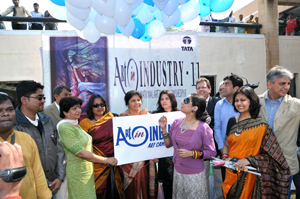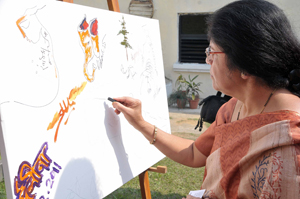Art-in-Industry, 2011
~ Masters and colours set out to create masterpieces ~
 The concept of Art-in-Industry dates back to 1943 when Tata Steel was one of the prize-donors of an exhibition and sale of art in the J. J. School of Art, Mumbai, wherein artists were invited to compete for prizes and scholarships. The aim even then was not merely be able to sell the entries or acquire the paintings, but also to bring the talent of lesser known artists to the notice of leading industrialists and patrons of art. It was in 1994 that the first Art-in-Industry camp was formally launched by Tata Steel in Jamshedpur.
The concept of Art-in-Industry dates back to 1943 when Tata Steel was one of the prize-donors of an exhibition and sale of art in the J. J. School of Art, Mumbai, wherein artists were invited to compete for prizes and scholarships. The aim even then was not merely be able to sell the entries or acquire the paintings, but also to bring the talent of lesser known artists to the notice of leading industrialists and patrons of art. It was in 1994 that the first Art-in-Industry camp was formally launched by Tata Steel in Jamshedpur.
The motive behind organizing Art-in-Industry camps in Jamshedpur in conjunction with established art galleries in the country was the belief that art was the most truthful reflection of a nation’s ethos and history, its achievements and short-comings, its life and growth. The art galleries brought their best group of young and seasoned artists to a week-long camp on the lush green lawns of the Centre for Excellence, an ambience that lent itself for artists to give vent to their expressions in styles distinctly their own.
 It was with the idea that art in partnership with industry should provide local artists with a platform such that it touches the lives of more people than they would otherwise have done, that art camps underwent a change in nature and character. The thrust of the camp therefore shifted to local and tribal artists from in and around Jamshedpur. The interest should be in the well being of artists as much as in art itself because an artist’s creativity has to be unfettered in order to grow and mature. The effort therefore aims to create a support system for tribal talent to bloom under Tata Steel’s patronage, finally putting the region on the cultural map of India.
It was with the idea that art in partnership with industry should provide local artists with a platform such that it touches the lives of more people than they would otherwise have done, that art camps underwent a change in nature and character. The thrust of the camp therefore shifted to local and tribal artists from in and around Jamshedpur. The interest should be in the well being of artists as much as in art itself because an artist’s creativity has to be unfettered in order to grow and mature. The effort therefore aims to create a support system for tribal talent to bloom under Tata Steel’s patronage, finally putting the region on the cultural map of India.
Tata Steel took the concept of art-in-industry to other areas of work like Bhubaneswar and Raipur; the concentric circle becoming larger each time and embracing new, budding artists from those regions.
For the first time we have introduced the Jamshedpur School of Art Corner where students get a rare opportunity to interact with prestigious artists. The aim of this workshop is to provide a learning experience for the students to see, understand and imbibe painting techniques of so many senior artists at one time. We have also made the art camp more inclusive by inviting associated companies and schools to visit the camp and enjoy watching the artists at work.
Tata Steel proudly presents Art-in-Industry Camp-11 at the Centre for Excellence from 4th to 7th February 2011. This national level art camp will see artists from all four corners of the country- Jammu and Kashmir in the North to Bangalore in the South, from Bengal, Bihar, Jharkhand and Orissa in the East to Mumbai and Gujarat in the West.
The painters in this exhibition have their individual methods developed in accordance with their vision and temperament. Art from a particular region fulfils a dual purpose. It allows viewers to enjoy art from a specific location while it is also a window to the way of life of the people of the region.
- Rini Dhumal is one of the senior most artists of India. She is basically a print-maker. Her portraits resemble the Kalighat photo paintings of old Kolkata.
- JMS Mani’s subject portrays human ties in rural India. His earthy colours is the result of using a spatula more than a brush to bring alive his subjects.
- Ravinder Salve’s art has some Japanese influence. He creates richly brocaded celestial beings of beauty.
- We can easily say that Tapan Dash’s paintings are influenced by Picaso. His medium of choice is oil and acrylic. His subjects border on the fantasy and dream element.
- Shyam Sharma is also a print maker. His work is experimental in style, fixing a “Purana panna” on the canvas at first and filling it with contrasting colours.
- Manash Jena is one of the well known artists from Orissa. His specialtyare portraits of women and is recognized by his Pratiksha series.
- Visual appeal is an important part of Eleena Banik’s work. She treats her canvas in a dramatic way. Her expressions emerge from a story or a fantasy.
An exhibition of finished paintings will be on display on 7th February from 11a.m. to 5 p.m. We hope that art lovers of the Steel city enjoy this rich experience of witnessing colours and masters as they set out to create masterpieces together.










